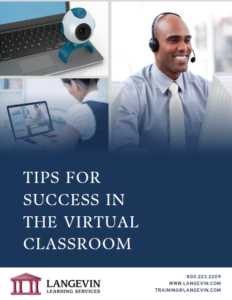Photo by: VioletaStoimenova via Canva
With virtual learning booming like never before, being a skilled virtual classroom facilitator is a must! It’s not just about knowing the tech. It’s about creating an environment that’s fun, engaging, and productive—just like a good old face-to-face classroom. But what exactly makes a virtual facilitator great? Let’s dive into the key characteristics that can turn your virtual sessions into a hit!
Tech-Savvy with a Smile
Let’s face it, virtual classrooms come with their own set of tech challenges. From managing Adobe Connect or Teams to handling whiteboards and chat boxes, a great facilitator knows their way around the tools. But it’s more than just clicking buttons; it’s about keeping a cool head when things don’t go as planned. Is someone stuck in a breakout room? Is your camera not working? Instead of panicking, a good facilitator stays calm, maybe cracks a joke, and fixes the issue without missing a beat.
Great Communication Skills
Communication in a virtual setting is different from in-person, and a good facilitator adjusts for that. Since non-verbal cues are harder to pick up, they make sure their instructions and explanations are clear, concise, and easy to follow. Plus, they actively encourage participation—whether that’s through open discussions, polls, or group activities. They don’t talk at the participants, they talk with them, ensuring everyone feels involved.
Engagement Magician
What’s one of the biggest challenges in virtual learning? Keeping people engaged. A great facilitator knows how to break through the screen and make things interesting. Whether it’s throwing in a quick interactive quiz, using breakout rooms for small group discussions, or telling a funny story to make a point, they keep things moving and avoid that dreaded “Zoom fatigue.” They sprinkle in a bit of fun to keep the energy up and make learning enjoyable, even when it’s online.
Master of Time Management
Virtual sessions can easily get off track, especially when technology or participants go rogue. A good facilitator balances keeping the class on schedule while giving enough time for important discussions and questions. They don’t rush through the material but also don’t let things drag. Pacing is key—knowing when to move on, when to dive deeper, and when to give participants a breather (yes, stretch breaks are a thing!).
Empathy and Patience
In the virtual world, there’s a wide range of tech skills among participants. Some might be pros at using the platform, while others are clicking all the wrong buttons. A great facilitator is patient and empathetic with everyone, offering help without making anyone feel uncomfortable or left behind. They nurture a supportive atmosphere where participants feel safe to ask questions, make mistakes, and learn at their own pace.
Adaptability Is Key
What happens when the Wi-Fi goes out or the platform crashes? A good virtual classroom facilitator rolls with the punches. They’re flexible and ready to adapt on the fly, whether that means switching platforms, modifying activities, or rescheduling a session. Virtual environments can be unpredictable, but a facilitator who can think on their feet and stay positive will keep the learning train on track no matter what.
In a nutshell, being a great virtual facilitator means mastering the tech, keeping things engaging, and being flexible. It’s all about creating a learning space that’s inclusive, fun, and productive—even when it’s online!
Are you ready to explore each of these characteristics in greater depth? And learn how to leverage, adapt, and transition your skills and experience as a traditional classroom trainer to the virtual classroom? Check out our workshop for virtual facilitators—The Virtual Trainer.


